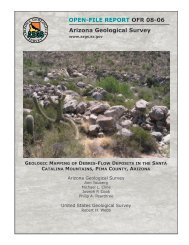geothermal resource potential of the safford-san simon basin, arizona
geothermal resource potential of the safford-san simon basin, arizona
geothermal resource potential of the safford-san simon basin, arizona
Create successful ePaper yourself
Turn your PDF publications into a flip-book with our unique Google optimized e-Paper software.
Cactus Flat-Artesia Area<br />
Geology<br />
Figure 15 is a geologic map <strong>of</strong> <strong>the</strong> Cactus Flat-Artesia area.<br />
The<br />
Pinaleno Mountains, composed mainly <strong>of</strong> gneiss, form <strong>the</strong> western boundary <strong>of</strong><br />
<strong>the</strong> Safford Basin.<br />
Physiographically, <strong>the</strong>se mountains form a steep escarpment<br />
cut deeply by several nor<strong>the</strong>ast-striking canyons which follow easily<br />
eroded shear zones. These shear zones may allow significant ground water<br />
recharge and enhance <strong>potential</strong> for forced convection in <strong>the</strong> adjacent <strong>basin</strong>.<br />
During mapping <strong>of</strong> <strong>basin</strong>-fill sediments and surficial deposits, several<br />
small pediment scarps transverse to drainage and parallel to <strong>the</strong> mountain front<br />
were observed. Subsequent studies by Chris Menges (person. corom., 1980) have<br />
documented shearing in <strong>the</strong> Cenozoic <strong>basin</strong> fill exposed in an arroyo north <strong>of</strong><br />
Marijilda Canyon adjacent to and on strike with one <strong>of</strong> <strong>the</strong> mapped scarps.<br />
It<br />
is believed <strong>the</strong>se scarps represent at least one Pleistocene faulting episode.<br />
In this area, gravel caps <strong>of</strong> various ages cover Cenozoic <strong>basin</strong> fill and form<br />
<strong>the</strong> pediment surfaces.<br />
The surfaces displaced by faulting may be mid-to-late<br />
Pleistocene age, judging from <strong>the</strong>ir soil and caliche development (Morrison<br />
and Menges, 1981). Recent and probable late Pleistocene gravel caps do not<br />
have scarps.<br />
Because <strong>the</strong> scarps are related to Pleistocene tectonism, <strong>the</strong>y<br />
may have an important bearing on <strong>the</strong> location <strong>of</strong> <strong>the</strong> areas with greatest <strong>geo<strong>the</strong>rmal</strong><br />
energy <strong>potential</strong>.<br />
Pleistocene faults are frequently associated with<br />
<strong>geo<strong>the</strong>rmal</strong> systems.<br />
Apparently young faults provide good vertical permeability<br />
for flows <strong>of</strong> <strong>the</strong>rmal water.<br />
Surface mapping <strong>of</strong> <strong>the</strong> <strong>basin</strong>-filling sediments shows that <strong>the</strong> top <strong>of</strong><br />
<strong>the</strong> green clay facies <strong>of</strong> Harbour (1966)<br />
is about 3,340 feet <strong>of</strong> elevation.<br />
Roadcuts along U.S.<br />
666 near Artesia show outcrops <strong>of</strong> stratified clay and<br />
50

















